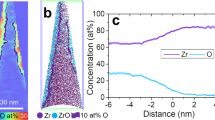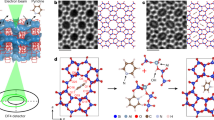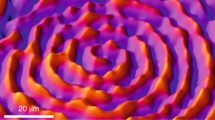Abstract
The modern chemical industry uses heterogeneous catalysts in almost every production process1. They commonly consist of nanometre-size active components (typically metals or metal oxides) dispersed on a high-surface-area solid support, with performance depending on the catalysts’ nanometre-size features and on interactions involving the active components, the support and the reactant and product molecules. To gain insight into the mechanisms of heterogeneous catalysts, which could guide the design of improved or novel catalysts, it is thus necessary to have a detailed characterization of the physicochemical composition of heterogeneous catalysts in their working state at the nanometre scale1,2. Scanning probe microscopy methods have been used to study inorganic catalyst phases at subnanometre resolution3,4,5,6, but detailed chemical information of the materials in their working state is often difficult to obtain5,6,7. By contrast, optical microspectroscopic approaches offer much flexibility for in situ chemical characterization; however, this comes at the expense of limited spatial resolution8,9,10,11. A recent development promising high spatial resolution and chemical characterization capabilities is scanning transmission X-ray microscopy4,12,13, which has been used in a proof-of-principle study to characterize a solid catalyst14. Here we show that when adapting a nanoreactor specially designed for high-resolution electron microscopy7, scanning transmission X-ray microscopy can be used at atmospheric pressure and up to 350 °C to monitor in situ phase changes in a complex iron-based Fisher–Tropsch catalyst and the nature and location of carbon species produced. We expect that our system, which is capable of operating up to 500 °C, will open new opportunities for nanometre-resolution imaging of a range of important chemical processes taking place on solids in gaseous or liquid environments.
This is a preview of subscription content, access via your institution
Access options
Subscribe to this journal
Receive 51 print issues and online access
$199.00 per year
only $3.90 per issue
Buy this article
- Purchase on Springer Link
- Instant access to full article PDF
Prices may be subject to local taxes which are calculated during checkout



Similar content being viewed by others
References
Bell, A. T. The impact of nanoscience on heterogeneous catalysis. Science 299, 1688–1691 (2003)
Weckhuysen, B. M. Chemistry: Catalysts live and up close. Nature 439, 548 (2006)
Hansen, T. W. et al. Atomic-resolution in situ transmission electron microscopy of a promoter of a heterogeneous catalyst. Science 294, 1508–1510 (2001)
Hitchcock, A. P., Dynes, J. J., Johansson, G., Wang, J. & Botton, G. Comparison of NEXAFS microscopy and TEM-EELS for studies of soft matter. Micron 39, 311–319 (2008)
Zambelli, T., Barth, J. V., Wintterlin, J. & Ertl, G. Complex pathways in dissociative adsorption of oxygen on platinum. Nature 390, 495–497 (1997)
Frenken, J. & Hendriksen, B. The reactor-STM: A real-space probe for operando nanocatalysis. MRS Bull. 32, 1015–1021 (2007)
Creemer, J. F. et al. Atomic-scale electron microscopy at ambient pressure. Ultramicroscopy 108, 993–998 (2008)
Roeffaers, M. B. J. et al. Spatially resolved observation of crystal-face-dependent catalysis by single turnover counting. Nature 439, 572–575 (2006)
Zurner, A., Kirstein, J., Doblinger, M., Brauchle, C. & Bein, T. Visualizing single-molecule diffusion in mesoporous materials. Nature 450, 705–708 (2007)
Kox, M. H. F., Stavitski, E. & Weckhuysen, B. M. Nonuniform catalytic behavior of zeolite crystals as revealed by in situ optical microspectroscopy. Angew. Chem. Int. Ed. 46, 3652–3655 (2007)
Stavitski, E., Kox, M. H. F., Swart, I., de Groot, F. M. F. & Weckhuysen, B. M. In situ synchrotron-based IR microspectroscopy to study catalytic reactions in zeolite crystals. Angew. Chem. Int. Ed. 47, 3543–3547 (2008)
Warwick, T. et al. A scanning transmission X-ray microscope for materials science spectromicroscopy at the Advanced Light Source. Rev. Sci. Instrum. 69, 2964–2973 (1998)
Kilcoyne, A. L. D. et al. Interferometer-controlled scanning transmission X-ray microscopes at the Advanced Light Source. J. Synchrotron Radiat. 10, 125–136 (2003)
Drake, I. J. et al. An in situ cell for characterization of solids by soft X-ray absorption. Rev. Sci. Instrum. 75, 3242–3247 (2004)
Dry, M. E. in Catalysis - Science and Technology (eds Anderson, J. R. & Boudart, M.) 160–255 (Springer, 1981)
Van der Laan, G. P. & Beenackers, A. Kinetics and selectivity of the Fischer-Tropsch synthesis: A literature review. Catal. Rev. Sci. Eng. 41, 255–318 (1999)
de Smit, E. & Weckhuysen, B. M. The renaissance of iron-based Fischer-Tropsch synthesis: On the multifaceted catalyst deactivation behaviour. Chem. Soc. Rev. doi: 10.1039/B805427D (in the press)
Heijboer, W. M. et al. In-situ soft X-ray absorption of over-exchanged Fe/ZSM5. J. Phys. Chem. B 107, 13069–13075 (2003)
de Groot, F. & Kotani, A. Core Level Spectroscopy of Solids (Taylor & Francis, 2008)
de Groot, F. M. F. et al. Oxygen 1s x-ray-absorption edges of transition-metal oxides. Phys. Rev. B 40, 5715–5723 (1989)
Sharp, T. et al. Distinction between six- and fourfold coordinated silicon in SiO2 polymorphs via electron loss near edge structure (ELNES) spectroscopy. Phys. Chem. Miner. 23, 17–24 (1996)
Davoli, I. et al. Structure of densified vitreous silica: Silicon and oxygen XANES spectra and multiple scattering calculations. Phys. Chem. Miner. 19, 171–175 (1992)
Wielers, A. F. H., Kock, A. J. H. M., Hop, C. E. C. A., Geus, J. W. & van der Kraan, A. M. The reduction behavior of silica-supported and alumina-supported iron catalysts: A Mössbauer and infrared spectroscopic study. J. Catal. 117, 1–18 (1989)
Zhang, C. H., Wan, H. J., Yang, Y., Xiang, H. W. & Li, Y. W. Study on the iron-silica interaction of a co-precipitated Fe/SiO2 Fischer-Tropsch synthesis catalyst. Catal. Commun. 7, 733–738 (2006)
Jozwiak, W. K., Kaczmarek, E., Maniecki, T. P., Ignaczak, W. & Maniukiewicz, W. Reduction behavior of iron oxides in hydrogen and carbon monoxide atmospheres. Appl. Catal. A Gen. 326, 17–27 (2007)
Wang, F., Malac, M. & Egerton, R. F. Alternative methods of identifying the oxidation of metallic nanoparticles embedded in a matrix. Micron 38, 371–376 (2007)
Braun, A. et al. Advantages of soft X-ray absorption over TEM-EELS for solid carbon studies - a comparative study on diesel soot with EELS and NEXAFS. Carbon 43, 117–124 (2005)
Urbonaite, S. et al. EELS studies of carbide derived carbons. Carbon 45, 2047–2053 (2007)
Thibault, P. et al. High-resolution scanning X-ray diffraction microscopy. Science 321, 379–382 (2008)
Le Gros, M. A., McDermott, G. & Larabell, C. A. X-ray tomography of whole cells. Curr. Opin. Struct. Biol. 15, 593–600 (2005)
Acknowledgements
We acknowledge financial support for this research work from the Dutch National Science Foundation in the form of two VICI grants (to F.M.F.d.G. and B.M.W.), a grant from the Netherlands Research School Combination on Catalysis (to B.M.W. and F.M.F.d.G.) and a grant from Shell Global Solutions (to B.M.W.). The Advanced Light Source is supported by the Director, Office of Science, Office of Basic Energy Sciences, US Department of Energy. The nanoreactors were fabricated with the assistance of the DIMES ICP-group and the Nanofacility of TU Delft.
Author information
Authors and Affiliations
Corresponding authors
Rights and permissions
About this article
Cite this article
de Smit, E., Swart, I., Creemer, J. et al. Nanoscale chemical imaging of a working catalyst by scanning transmission X-ray microscopy. Nature 456, 222–225 (2008). https://doi.org/10.1038/nature07516
Received:
Accepted:
Issue Date:
DOI: https://doi.org/10.1038/nature07516
This article is cited by
-
Operando magnetic resonance imaging of product distributions within the pores of catalyst pellets during Fischer–Tropsch synthesis
Nature Catalysis (2023)
-
Visualizing interface-specific chemical bonds in adhesive bonding of carbon fiber structural composites using soft X-ray microscopy
Scientific Reports (2022)
-
Imaging Cu2O nanocube hollowing in solution by quantitative in situ X-ray ptychography
Nature Communications (2022)
-
Physical and chemical imaging of adhesive interfaces with soft X-rays
Communications Materials (2021)
-
Metallic Nanoparticles in Heterogeneous Catalysis
Catalysis Letters (2021)
Comments
By submitting a comment you agree to abide by our Terms and Community Guidelines. If you find something abusive or that does not comply with our terms or guidelines please flag it as inappropriate.



